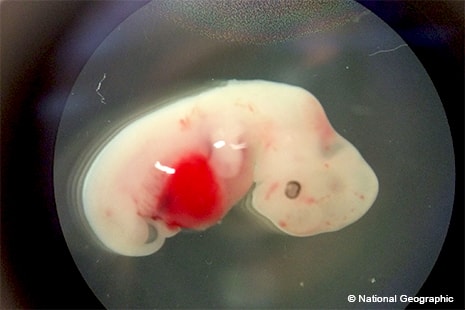Scientists develop the first step to growing human organs
Orange County, CA - January 27th 2017 - There are currently more than 119,000 people waiting for an organ transplant in the United States. Every 10 minutes another person is added to the waiting list and with 22 people on that list dying each day there is a deficiency in supply. Providing the proper organs to patients is essential in giving these individuals a second chance at life. In an attempt to combat the shortage of human donors, Salk Institute in La Jolla, California has started to grow human cells inside pig embryos in hopes of one day being able to harvest human organs for transplant.
Growing the cells within the pig occur after injecting the embryos with three to ten human stem cells, cells that can produce a variety of specialized cells, researches then implanted the embryos into sows. After four weeks the developing 186 embryos were removed and investigated.
While author Juan Carlos Izpisua Belmonte says the research is far from its ultimate goal of growing human organs in pigs, he did say it was, "just a very early step toward the goal."

Mixing different cells within an animal, called a chimera, has been done previously with mice and rats, but to develop human-sized organs, a larger host animal would be needed. This type of research was suspended from government funding in 2015 after it raising ethical concerns. Scientists worried the research could accidentally lead to the animal developing human characteristics in the brain or the prospect of them developing human eggs or sperm, but that has not been detected in any testing. In the current experiment less than 1 in every 100,000 embryonic cells was human, which resulted in around one million human cells. While lower than expected, researchers were able to see the human cells after three to four weeks of development.
The research has prompted the government to reconsider their ban on the research as well as give insight into which and how many cells should appear in the embryo. The pigs may not need to come to term, for the fetus is able to provide physicians with human pancreatic cells to treat diabetes, or kidney cells to repair the organ. The cells produced by chimeras alone could aid in studies of genetic disease development and potential routes for new drug screenings.
Insoo Hyun of Case Western Reserve University in Cleveland, an ethics expert, said, “It really does give a green light [for further exploration].” He understands society’s cautious stance in broaching this topic, but wants people to know, "this is a strategy to help save human lives," and is justified.
To read their full study, click here.
Contact Ampronix:

Email: info@ampronix.com
International Sales: +1 949-273-8000
Domestic Sales: 1800-400-7972 for US and Canada
Follow Us:
Share This Article:
View our Product Catalog Online Here
About Ampronix
Ampronix is a renowned authorized master distributor of the medical industry's top brands as well as a world-class manufacturer of innovative technology. Since 1982, Ampronix has been dedicated to meeting the growing needs of the medical community with its extensive product knowledge, outstanding service, and state-of-the-art repair facility. Ampronix prides itself on its ability to offer tailored, one-stop solutions at a faster and more cost-effective rate than other manufacturers. Ampronix is an ISO & ANSI/ESD certified facility. To learn more go here.
Scientists develop the first step to growing human organs Orange County, CA – January 27th 2017 – There are currently more than 119,000 people waiting for an organ transplant in the United States. Every 10 minutes another person is added to the waiting list and with 22 people on that list dying each day there is […]



